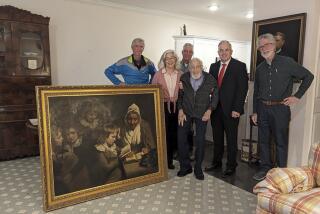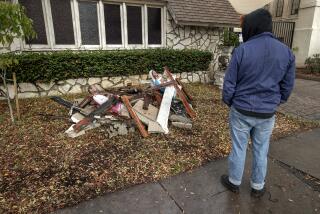Religious Icons Valued as Extensions of the Faith : Orthodoxy: New York church celebrates return of painting despite missing gold and jewels. Believers ‘do not pray to the icons, we pray through them,’ expert says.
- Share via
In recent publicity about the theft of a treasured icon from a New York City church, the focus was often on jewels and gold, giving the impression that the value of the painting is measured in carats.
But the true significance of icons to Orthodox congregations is as deep and mysterious as faith itself.
“The icon is like a window into heaven. It is at the horizon at which heaven and earth meet,” said Dennis Bell, an iconographer from Plainsville, Ohio.
So when members of St. Irene of Chrysovalantou Greek Orthodox Church in Astoria, Queens, learned of the Dec. 23 theft by gunmen of the painting of the church’s namesake, the loss they felt went far beyond the item’s monetary value or its decorative function.
In Orthodox Christianity, icons are inseparable from belief. They are viewed as extensions of the interior life of the church, objects that place believers in touch with the spiritual world.
“Icons are not religious art, not sacred art, they’re liturgical art,” said Bell, trying to explain the deep feelings that erupted when the icon was stolen and when it was later returned by mail to the church, minus about $800,000 in gold and jewels.
“Being liturgical, they have a function within the liturgy. They are not just decorative, they participate in the liturgy.”
In Orthodox thought, the icon is actually a kind of incarnation, in that the elements--often wood, gold leaf and paint--that make up the image are believed to be sanctified, or made holy. Orthodox theology teaches that the icons actually participate in the holiness of the person they depict.
Unlike statues, which are normally viewed by Catholic and Orthodox worshipers as aids to prayer and holiness because they are vivid reminders of saintly figures, icons are revered and venerated as actual doorways to the spiritual world.
Believers “do not pray to the icons, we pray through them,” said Bell, who is president of the St. John Damascus Assn. of Iconographers, Iconologists and Architects, based in Ligonier, Pa.
He admits the concept is difficult for someone outside the faith to understand. “You have to live the experience,” he said. “How can someone who has gone to the moon adequately describe the experience? But it is not for us who have not been there to judge that experience.”
In Queens, lavish celebration marked the return of the statue, which is said to have wept tears of grief last year just before the start of the Gulf War. Some worshipers have attributed personal miracles to the icon of Irene as well.
The place of honor the icon enjoys, even without the encrusted jewels, was evident in the emotional response of scores of parishioners and in the remarks of Bishop Vikentios of Avlon, spiritual leader of the church, when it was returned Dec. 28.
Church members turned out to rejoice, and the tears and the prayers flowed as many lined up to kiss the glass covering the face of the saint.
More to Read
Sign up for Essential California
The most important California stories and recommendations in your inbox every morning.
You may occasionally receive promotional content from the Los Angeles Times.












